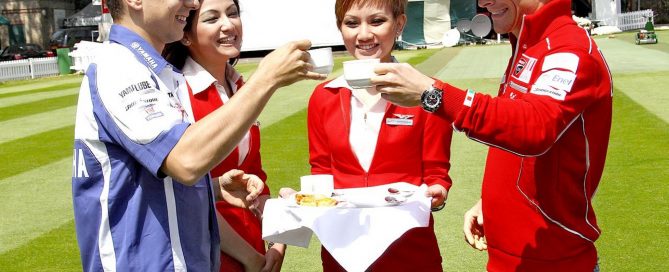Pecco poised to join the greats on the honours board
Twelve years ago, I took a bemused Jorge Lorenzo and Nicky Hayden to the legendary Lord’s Cricket Ground in London, the home of world cricket. It was a media pre-event before the British Grand Prix and the two World Champions were more than a little confused attempting to play the great game, but were fascinated by the honours board in the pavilion. Any player who had taken more than five wickets in one innings, known as a ‘Fifer’, was honoured. Around one hundred names starting back in 1884 were listed
Pecco Bagnaia arrives at Aragon this weekend determined to find his name on a shorter MotoGP™ Fifer honours board. The Italian Ducati rider has won the last four Grands Prix and since 1949, only seven riders in the premier class would have their names engraved on that imaginary MotoGP™ special board. Those seven are the only riders in the 74-year history of our sport to have won five or more consecutive premier class Grands Prix.
No great surprise at the names and especially the top man. Between the 1968 West German Grand Prix and the 1969 Ulster Grand Prix, 15-times World Champion Giacomo Agostini won 20 consecutive 500cc Grands Prix. Riding the MV Agusta, Ago won at some remarkably diverse venues including the Isle of Man TT circuit, Imatra in Finland, Montjuic Park in Spain and the Sachsenring, Brno and Nürburgring road circuits.
Both Mike Hailwood and John Surtees took full advantage of the superiority of the MV against their mainly single-cylinder challengers. Hailwood won 12 successive 500cc races between the 1963 Belgium Grand Prix and East Germany a year later. Surtees made it 11 in a row, including victory in every one of the seven 1959 World Championship races. Another British star, Geoff Duke, was the first rider to win five in a row. Riding the 500cc four-cylinder Gilera, Duke won the 1954 Belgium, Dutch, West German, Swiss and Nations Grands Prix to set the ball rolling.
Five-time World Champion Mick Doohan fought back from serious injury to win ten in a row for Honda in the nineties. The Australian won ten of the 15 1997 rounds in succession. Doohan would have moved into second place behind Ago with 13 successive wins if teammate Alex Criville had not beaten him at Jerez to the delight of the home crowd.
Who will forget 2014 and the next Honda multi–World Champion? Surely Marc Marquez could not repeat his rookie success of the previous year and retain his MotoGP™ world title? Any doubts disappeared in a cloud of exhaust smoke as the young Spaniard won the opening ten races of the season. It was only in August that the run finally came to a halt at Brno in a race won by his Honda teammate Dani Pedrosa.
No honours board would be complete without a certain Valentino Rossi and again it was on the Honda that the nine-time World Champion won seven in a row in 2002. He led the four-stroke charge winning nine Grands Prix that historic season. The Doctor won five in a row for Yamaha in 2005 and 2008 and for both Honda two-strokes and four strokes in 2001 and 2002.
Back to the cricket at Lord’s in 2010. The ground staff at this legendary venue were mostly Australian. They loved MotoGP™ and especially Casey Stoner. Incredibly they allowed the two World Champions to play a game on the famous second pitch at the Nursery end of the ground. Pictures of Jorge with pads on trying bat and Nicky chucking instead of bowling the ball were shown throughout the World. The groundsmen loved it until the Air Asia hostesses arrived on their hallowed turf wearing high-heeled shoes to serve the traditional strawberries and cream and cups of tea to the media. The game ended abruptly.
There should be no such interruptions for Pecco on Sunday as he strives to emulate some of the greats of our sport and join that very special Fifers club. Probably no strawberries and cream and cups of tea in pit lane if he does it.


